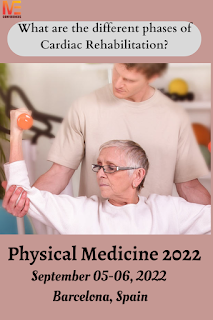What are the different phases of Cardiac Rehabilitation?
Cardiac rehabilitation, commonly
known as cardiac rehab, is a specialised outpatient exercise and education
programme. The programme is intended to assist you in improving your health and
recovering after a heart attack, various types of heart disease, or heart
surgery. Exercise training, emotional support, and teaching about lifestyle
changes to minimise your risk of heart disease, such as eating a heart-healthy
diet, maintaining a healthy weight, and quitting smoking, are all common
components of cardiac rehabilitation.
Establishing a strategy to help you
rebuild strength, keep your condition from worsening, lower your risk of future
heart problems, and enhance your health and quality of life are all goals of
cardiac rehabilitation. Cardiac rehabilitation programmes have been shown in
studies to minimise the chance of mortality from heart disease as well as the
risk of future heart problems. Cardiac rehabilitation is a treatment option for
persons suffering from various types of heart disease. If you have a medical
history that includes the following, cardiac rehabilitation may be beneficial
to you.
·
Heart attack
·
Coronary artery disease
·
Heart failure
·
Peripheral artery disease
·
Chest pain (angina)
Different
phases of Cardiac Rehabilitation:
The Acute Phase of Cardiac
Rehabilitation: After your cardiac episode, you should begin phase
one of your recovery as soon as feasible. Once you leave the ICU, he or she
will work with you in a stepdown unit. One of our physical therapists will
conduct an initial assessment of your condition. This person will question you
extensively about the events leading up to your heart attack and how you are
currently feeling.
Your Outpatient Rehabilitation
Program: It usually entails three to six weeks of outpatient
rehabilitation, during which a member of your care team continues to assess how
your body responds to activity. You'll learn how to exercise appropriately and
how to keep track of your own heart rate while doing so. Phase II's purpose is
to help you progress to more intense and autonomous physical activity.
Outpatient rehabilitation gets substantially more demanding as you progress to
Phase III. Our physical therapist will expect you to keep track of your own
workout responses, such as heart rate and perceived exertion. As you work
toward this objective, he or she will work with you to develop your tolerance
for exercise and troubleshoot any issues that emerge. During Phase III of
outpatient rehabilitation, you should expect another physical therapy
evaluation. Many of the measurements taken by your physical therapist while you
were still in the hospital will be included in this report.
Independent Ongoing Maintenance: Within a few
months of your cardiac episode, if you followed your care team's advice and
worked hard in the first three phases, you should be ready to operate
independently. A physical therapist is always ready to help you overcome
problems and invent new ways to challenge yourself with physical activity, even
if you exercise and evaluate your own risk factors at home. We realise how
frightening and life-changing a heart attack, open heart surgery, or another
heart-related health issue can be.



Comments
Post a Comment